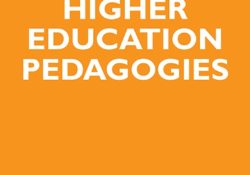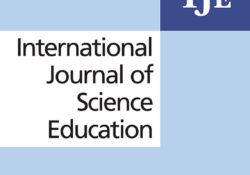tandfonline.com har udgivet en rapport under søgningen „Teacher Education Mathematics“: ABSTRACT Formulae display:?Mathematical formulae have been encoded as MathML and are displayed in this HTML version using MathJax in order to improve their display. Uncheck the box to turn MathJax off. This feature requires Javascript. Click on a formula to zoom. ABSTRACT In times of rapid transformation of society in general and domains of technology in particular, questions are raised on how to effectively organise higher engineering education. As a response, this study examines the curriculum composition of eleven engineering programs to investigate curriculum nativeness, a novel approach for assessing curriculum characteristics. In addition to forming the construct nativeness, this study establishes a way to measure curriculum nativeness by determining the number of credits originating from what is characterised as… Continue Reading →
Like this:
Like Loading...
tandfonline.com har udgivet en rapport under søgningen „Teacher Education Mathematics“: Abstract Abstract To understand the impact of the COVID-19 public health response on families of children with disabilities in Central Uganda we conducted phone interviews with parents and children during the first 5 months of the outbreak (March – July 2020). Most parents and children were well informed about COVID-19 and were keen to adhere to government prevention measures. The majority said lock-down measures had a negative effect on their mental and physical health, social life, finances, education and food security. Access to medical services and medication for chronic illness had been limited or absent due to restrictions in travel, some facilities restricting access, and limited financial resources. The majority of parents reported loss of work which resulted in difficulties in… Continue Reading →
Like this:
Like Loading...

tandfonline.com har udgivet en rapport under søgningen „Teacher Education Mathematics“: ABSTRACT ABSTRACT Since 2004, Aston University has been delivering work-based learning (WBL) engineering degrees to key UK Energy sector employers, such as National Grid. National measures for widening participation in HE, such as the Degree Apprenticeship Levy, have led to significant changes in learning background diversity of WBL cohorts, consequently increasing student requirement for additional learning-support in HE Institutions (HEIs). To address these challenges, an intervention strategy was formulated in collaboration with Aston University’s Learning Development Centre. Our methodology gradually embedded a provision of tailored learning-support sessions/workshops in mathematics and effective communication skills within WBL curricula. Integrating this support has led to marked increases in student engagement,grade-attainment, and stakeholder satisfaction. This case study is pertinent to HE’s current STEM sector… Continue Reading →
Like this:
Like Loading...
eric.ed.gov har udgivet: Within a response to intervention framework, teachers regularly base important instructional decisions on the results of formative assessments. The validity of these decisions depends, in part, upon the validity of the inference of students‘ skills drawn from the formative assessment. If formative assessment items do not genuinely measure the skills they purport to measure–that is, if they are misaligned with their content standards–then the resulting inferences may be threatened. Alignment is thus critical, given the potential practical repercussions of misalignment (e.g., students denied needed interventions). In the following technical report, we report on the alignment of a randomly selected sample of roughly half the easyCBM CCSS middle school math items with the Common Core State Standards (CCSS). Results suggest a high degree of alignment, with 87% of… Continue Reading →
Like this:
Like Loading...
eric.ed.gov har udgivet: This policy brief, a quick look at some aspects of the debate, illustrates the differences in New York City public schools that would result when layoffs are determined by seniority in comparison to a measure of teacher effectiveness. Due to data limitations and an interest in simplicity, this analysis employs the value added of teachers using the 4th and 5th grade math and ELA (English Language Arts) achievement of their students. Unsurprisingly, the authors find that layoffs determined by a measure of teacher effectiveness result in a more effective workforce than would be the case with seniority-based layoffs. However, they were surprised by facets of the empirical results. First, assuming readily available measures of teacher effectiveness actually measure true teacher effectiveness, an assumption to which they return… Continue Reading →
Like this:
Like Loading...
eric.ed.gov har udgivet: Since the emergence of middle schools as distinct educational settings in the 1960s, proponents of the model have advocated for structures and approaches that best meet the particular developmental needs of young adolescents. Middle school researchers have developed frameworks of best practices for schools that have been widely, if not uniformly, adopted. However, there is a paucity of large-scale quantitative research on the efficacy of such best practices. In this study we used state-level administrative data from Texas to estimate the school-level contribution to standardized test scores in math and language arts, along with absenteeism. We then regressed these value-added quantities on indicators of middle school structures, along with research-supported predictors of school efficacy. Results showed that schools with fewer classes in the school day and higher… Continue Reading →
Like this:
Like Loading...
tandfonline.com har udgivet en rapport under søgningen „Teacher Education Mathematics“: ABSTRACT ABSTRACT The aim of this study was to examine the association between students’ TIMSS (Trends in Mathematics and Science Study) science achievement, and students’ school achievements, in terms of national tests and grades from school years 6 and 9. Further to examine the association with TIMSS science achievement and different subgroups of students based on their home background. The study is based on a unique possibility to analyse TIMSS 2015 data together with register data of the Swedish students’ national test results from school years 6 and 9 and their science subject grades from school years 6 and 9. The overall results show that there were moderate associations between TIMSS science achievement and school achievement measures. The association between… Continue Reading →
Like this:
Like Loading...
eric.ed.gov har udgivet: States are increasingly interested in including measures of student achievement growth, or „value- added,“ in evaluating teachers. Annual state assessments, however, which are the typical measure of student growth, usually cover only reading and math teachers and only in grades 4-8. These state assessments thus cannot generally be used to measure contributions to student achievement growth for early elementary school teachers, most high school teachers, and teachers of other subjects. As a consequence, a growing number of states and school districts are exploring alternatives for measuring teachers‘ contributions to student learning. These alternatives have the potential to be used for evaluating not only teachers who work in grades and subjects outside the annual state testing regime but also as complementary growth measures for teachers of tested grades… Continue Reading →
Like this:
Like Loading...
eric.ed.gov har udgivet: States and districts are beginning to use student achievement growth–as measured by state assessments (often using statistical techniques known as value-added models or student growth models)–as part of their teacher evaluation systems. But this approach has limited application in most states, because their assessments are typically administered only in grades 3-8 and only in math and reading. In response, some districts have turned to alternative measures of student growth. These alternative measures include alternative assessment-based value-added models (VAMs) that use the results of end-of-course assessments or commercially available tests in statistical models, and student learning objectives (SLOs), which are determined by individual teachers, approved by principals, and used in evaluations that do not involve sophisticated statistical modeling. For this report, administrators in eight districts that were early… Continue Reading →
Like this:
Like Loading...
eric.ed.gov har udgivet: States and districts are beginning to use student achievement growth–as measured by state assessments (often using statistical techniques known as value-added models or student growth models)–as part of their teacher evaluation systems. But this approach has limited application in most states, because their assessments are typically administered only in grades 3-8 and only in math and reading. In response, some districts have turned to alternative measures of student growth. These alternative measures include alternative assessment-based value-added models (VAMs) that use the results of end-of-course assessments or commercially available tests in statistical models, and student learning objectives (SLOs), which are determined by individual teachers, approved by principals, and used in evaluations that do not involve sophisticated statistical modeling. For this report, administrators in eight districts that were early… Continue Reading →
Like this:
Like Loading...



